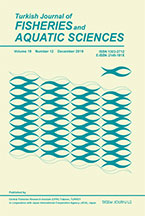Aquaculture Studies
2018, Vol 18, Num, 2 (Pages: 29-38)
Fatty Acid Profiles in Wild Axillary Seabream (Pagellus acarne) versus Cage-Aggregated and Cage-Farmed Fish with Reference to Nutritional Contribution for Human Consumers
2 Canakkale Onsekiz Mart University, Faculty of Marine Science and Technology, Departments of Aquaculture and Marine Technology Engineering, 17100, Canakkale, Turkey
3 Canakkale Onsekiz Mart University, Faculty of Marine Science and Technology, Department of Aquaculture, 17100-Canakkale, Turkey DOI : 10.4194/2618-6381-v18_2_04 Viewed : 10761 - Downloaded : 4103 Fatty acid profiles of cage-farmed axillary seabream (Pagellus acarne) were compared with their wild representatives aggregated around the cage system and those from a distance area far from the fish farm. Wild fish contained higher levels of polyunsaturated fatty acids (PUFA; 36.47 g/100 g lipid) than the cage-aggregated (30.16 g/100 g lipid) or cage-farmed fish (29.20 g/100 g lipid). However, the most salient difference between wild and farmed-fish was the fat content with two-times higher levels in the latter (7.70% versus 3.05%). This resulted in a higher nutritional contribution of eicosapentaenoic acid (EPA) and docosahexaenoic acid (DHA), which totally covered the recommendations of European Food Safety Authority (EFSA) with higher rate in cage-farmed (140%, CFF) and cage-aggregated axillary seabream (130%, CAF) compared to the wild populations of P. acarne from distant area (99%, WCF). As a result, all fish either farmed, cage-aggregated or wild-caught individuals met the minimum nutritional contribution for EPA+DHA in the order of CFF > CAF > WCF. Keywords : Fillet quality, Fatty acid, Health benefits, Pagellus acarne, Cage aggregation















